-
Sunny Side Ltd. began its operations on 1 July 2012 by raising Sh.52 million ordinary share
capital and issuing 18% per annum debentures.
The following information was...
(Solved)
Sunny Side Ltd. began its operations on 1 July 2012 by raising Sh.52 million ordinary share
capital and issuing 18% per annum debentures.
The following information was extracted from the books of the company for the year ended 30
June 2013:
1.
Item Sh. ‘000’
Dividends paid 3,376
Cash and bank balance 2,500
Operating costs (excluding finance cost) 31,320
Total non-current assets at net book value 60,000
2. The total current assets as at 30 June 2013 consisted
of: Σ Trade receivables.
Σ Inventory.
Σ Cash and bank balance.
3. The total current liabilities as at 30 June 2013 consisted of:
Σ Trade payables.
Σ Taxation charge for the year.
4. Taxation is to be provided for at the rate of 30% per annum.
5. 20% of the total sales for the year were made in cash.
6. Credit purchases during the year amounted to Sh. 28,800,000.
7. The accountant provided the following ratios which were determined from the financial
statements of the company:
Σ Inventory turnover 4.4 times
Σ Non-current asset turnover 1.8 times
Σ Gross profit margin 45%
Σ Average debt collection period 84 days
Σ Interest cover 4 times
Σ Average credit repayment period 90 days
Required:
i) Income statement for the year ended 30 June 2013.
ii) Statement of financial position as at 30 June 2013.
Note: Assume a year has 360 days.
Date posted:
May 16, 2019
.
Answers (1)
-
Explain the following terms as used in company accounts.
i) Cumulative preference shares.
ii) Public offer.
iii) Mortgaged debenture
(Solved)
Explain the following terms as used in company accounts.
i) Cumulative preference shares.
ii) Public offer.
iii) Mortgaged debenture
Date posted:
May 16, 2019
.
Answers (1)
-
Meja and Kariuki have been trading as partners sharing profits and losses in the ratio of their fixed
capitals. The statement of financial position of the...
(Solved)
Meja and Kariuki have been trading as partners sharing profits and losses in the ratio of their fixed
capitals. The statement of financial position of the partnership as at 31 March 2011 was as follows:
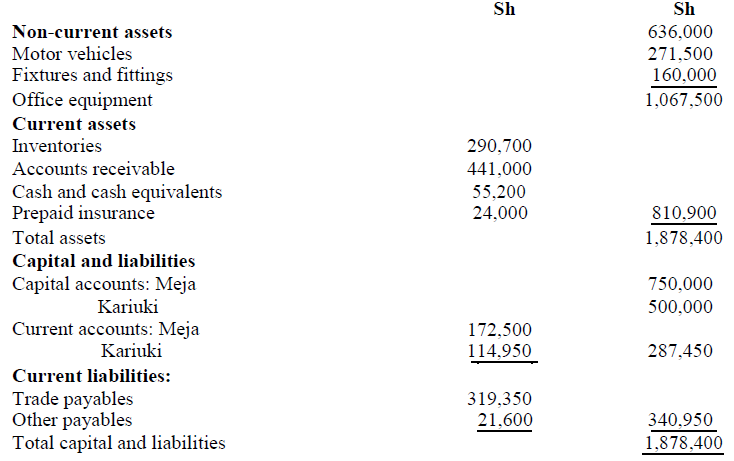
The partners have been having some disagreements on the following issues:
1. The historical cost of the assets did not reflect the fair value of the assets.
2. Although the partners contributed different amounts as fixed capital, the partnership agreement
did not provide for payment of interest on capital.
3. Kariuki devoted his entire working time to the business of the partnership but the partnership
agreement did not provide for any salaries for active partners.
4. Kariuki strongly believed that the present profits and losses sharing ratio was inequitable.
At a meeting convened to resolve the above issues, the partners agreed as follows:
i) The non-current assets as at 31 March 2011 were to be revalued as follows:
Sh.
Motor vehicles 600,000
Fixtures and fittings 262,500
Office equipment 225,000
ii) Inventories as at 31 March 2011 were to be written down to Sh. 275,000 and Sh 16,000 was
to be written off as bad debts. An allowance for doubtful debts of 5% was to be provided on
the remaining accounts receivable.
iii) Interest on capital was to be allowed at 5% per annum for the years ended 31 March 2010 and
31 March 2011.
iv) Kariuki was to be paid a salary of Sh 90,000 per annum for the years ended 31 March 2010
and 31 March 2011.
v) Profits and losses were to be shared equally with effect from 1 April 2009
vi) Meja was to be compensated for his loss arising from the new profit sharing agreement by
allowing him goodwill of Sh. 200,000.The goodwill would not be retained in the books of the
partnership. The net profits for the year ended 31 March 2009,2010 and 2011 were Sh.
425,000,Sh. 525000 and Sh. 412,500 respectively.
Required:
a) Adjusted income statement and appropriation 2011 account for the years ended 31 March 2010
and 31March 2011
b) Partners' current accounts.
c) Statement of financial position as at 31 March 2011.
Date posted:
May 16, 2019
.
Answers (1)
-
John and Joel were partners in a business sharing profits and losses in the ratio of 2:1. Interest on
fixed capital was allowed at the rate...
(Solved)
John and Joel were partners in a business sharing profits and losses in the ratio of 2:1. Interest on
fixed capital was allowed at the rate of 10% per annum. No interest was charged on current accounts.
On 30 September 2011 Joy was admitted as a partner and from that date profits and losses were to be
shared in the ratio of 2:2:1 for John, Joel and Joy respectively. Goodwill was not to be retained in the
books with adjusting entries being made in the current accounts.
The following trial balance was extracted from the partnership's books of account as at 31 March
2012:
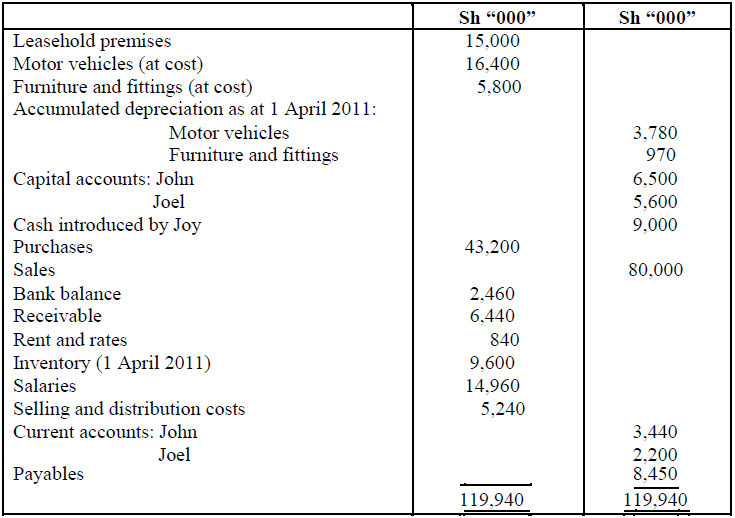
Additional information:
1. No entries have been made to record the admission of Joy. Goodwill was agreed at Sh.10.5
million. Sh.6 million of the cash introduced by Joy was the fixed capital.
2. Salaries include the following partners' drawings:
Sh ‘000’
John 2,580
Joel 2,040
Joy 680
3. Depreciation is to be provided as follows:
Asset Rate per annum
Motor vehicles 20% on cost
Furniture and fittings 10% on cost
4. The sales during the six month period from 1 October 2011 to 31 March 2012 were 50% more
than the sales during the six month period from 1 April 2011 to 30 September 2011. The selling
and distribution expenses varied with the sales.
All other expenses accrued evenly.
5. Inventory as at 31 March 2012 was valued at Sh.11 million.
6. Allowance for doubtful debts was Sh.229,000 as at 30 September 2011 and Sh.309,000 as at 31
March 2012.
7. The leasehold premises is to be amortised over 30 years from 31 March 2011
Required:
a) Income statement for the year ended 31 March 2012.
b) Statement of financial position as at 3 I March 2012.
c) Partners' current accounts.
Date posted:
May 16, 2019
.
Answers (1)
-
Kanini, Lucy and Ndwiga are in partnership sharing profits and losses in the ratio 3:2:1 respectively. Ndwiga decided to retire on 31 December 2012 and Gitonga...
(Solved)
Kanini, Lucy and Ndwiga are in partnership sharing profits and losses in the ratio 3:2:1 respectively.
Ndwiga decided to retire on 31 December 2012 and Gitonga was admitted as a partner on that date.
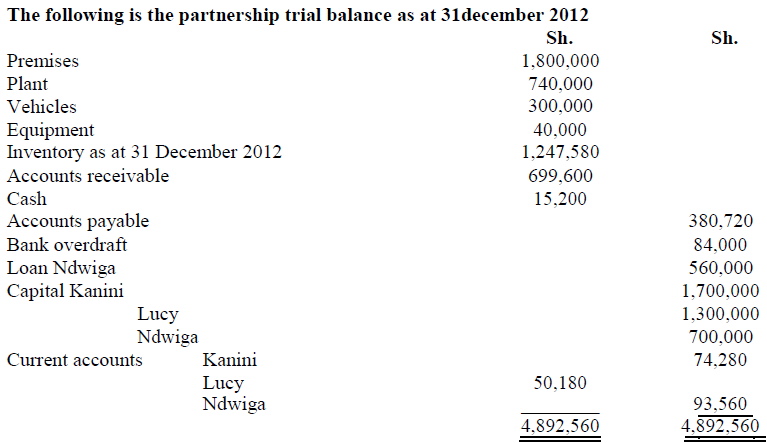
Additional information
1. Revaluation premises Sh. 2,400,000 plant Sh. 700,000 and inventory Sh. 1,083,580
2. Allowance for doubtful debts amounting to sh. 60,000 is to be provided
3. Goodwill amounting to sh. 840,000 is to be recorded in the books on the day Ndwiga retires. The
partners in the new partnership do not wish to maintain goodwill.
4. Kanini and Lucy are to share profits in the same ratio as before. Gitonga will have the same
share of profits as Lucy.
5. Ndwiga is to take his car at book value of sh. 78,000 in part payment and the balance of all he is
owned by the firm in cash except sh. 400,000 which he is willing to leave as a loan account.
6. The partners in the new firm are to start on equal footing so far as capital and current accounts are
concerned. Gitonga is to contribute cash to bring his capital and current accounts to the same
amount as the original partner from the old firm who has the lower investment in the business
7. The original partner in the old firm who has the higher investment will draw cash so that capital
and current account balances equal those of his new partners
Required;-
a) Partners capital account
b) Partners current account
c) Statement of financial position for the partnership of Kanini, Lucy and Gitonga as at 31
December 2012
Date posted:
May 16, 2019
.
Answers (1)
-
Sylivia and William are in a partnership business trading under the name Slywill Enterprises. Their
statement of financial position as at 31 October 2013 failed to...
(Solved)
Sylivia and William are in a partnership business trading under the name Slywill Enterprises. Their
statement of financial position as at 31 October 2013 failed to agree. The difference was-posted to a
suspense account pending investigations as shown below:
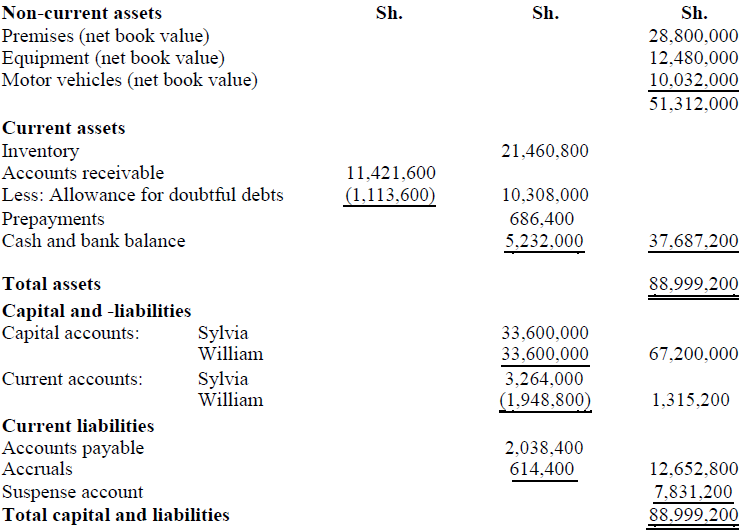
Additional information:
After checking all the entries, the following errors were discovered:
1. Discounts received of Sh. 633,600 had been debited to discounts allowed account.
2. The sales account had been undercast by Sh. 4,800,000.
3. The purchase returns day book had been correctly entered and totalled at Sh. 2,956,800 but had
not been posted to the ledger.
4. A credit sale of Sh. 705,600 had been debited to the customer's account as Sh. l,029,600.
5. A motor vehicle originally bought for Sh.3,360,000 four years ago and depreciated at 20% using
the straight-line method had a residual value of Sh.480,000. The motor vehicle was disposed of at
Sh.1,440,000
No entries, other than bank account, had been passed through the books.
6. An accrual of Sh. 268,800 for electricity charges had been omitted from the books.
7. A bad debt of Sh. 748,800 had not been written off.
8. Allowance for doubtful debts should be maintained at 10% of accounts receivable.
9. Sylvia's current account had been credited with a partnership salary of Sh. 1,440,000 which
should have been credited to William’s current account.
10. Sylvia had withdrawn goods worth Sh.940,800 for personal use. No entry had been made in the
partnership books.
11. The partners share profits as follows:
Sylvia - 60%
William - 40%
Required:
a) Suspense account, duly balanced, for the year ended 31 October 2013
b) Statement of adjustments to show the correct net profit for the year ended 31 October 2013
c) Partners' current accounts.
d) Statement of financial position as at 31 October 2013.
Date posted:
May 16, 2019
.
Answers (1)
-
The following balances were extracted from the boob of Chuma Enterprises as at 30 September 2003.
Additional information:
1. Provision for depreciation on the motor vehicle and...
(Solved)
The following balances were extracted from the boob of Chuma Enterprises as at 30 September 2003.
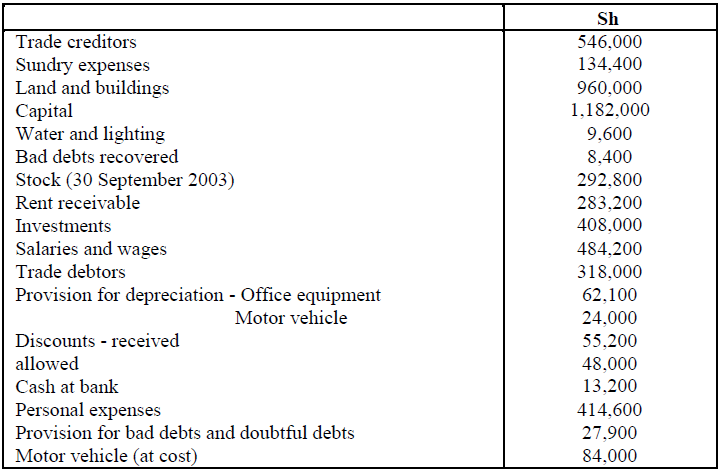

Additional information:
1. Provision for depreciation on the motor vehicle and office equipment is to be provided so as to
reflect two years depreciation at the rate of 20% per annum on cost.
2. Rent received amounting to Sh.6,000 has not been recorded ill the accounts. The
proprietor converted this money to personal use.
3. The sales day book had been overcast by Sh.9,000.
4. Discounts allowed amounting to Sh.7,200 had been posted to the discounts allowed account but
not to the debtors account.
5. The sales returns day book had been overcast by Sh1,800.
6. Stock at 30 September 2003 included an item valued at Sh.60,000 which had been sold and
invoiced to a customer on 30 September 2003.
Required:
a) Profit and loss account for the year ended 30 September 2003
b) Balance sheet as a. 30 September 2003
Date posted:
May 16, 2019
.
Answers (1)
-
The following trial balance was extracted from the books of T. Onyancha a sole trader,
Additional information:
1. Stock as at 31 December 2003 was valued at...
(Solved)
The following trial balance was extracted from the books of T. Onyancha a sole trader,

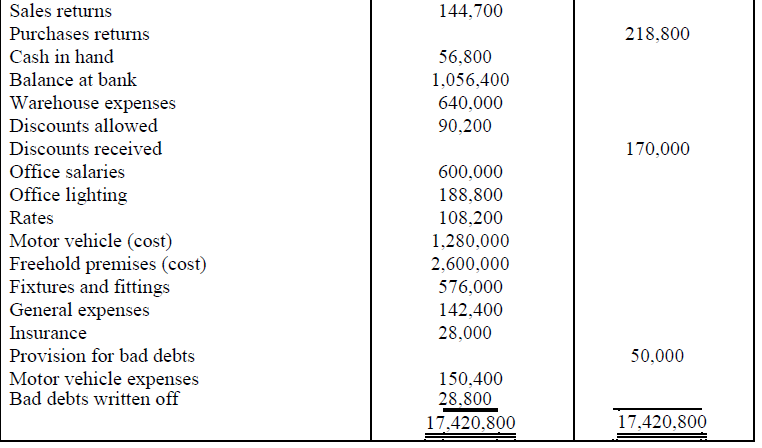
Additional information:
1. Stock as at 31 December 2003 was valued at Sh. 1,760,000
2. Depreciation on fixtures and fittings and the motor vehicle is to be provided at the rate of 5% and
10% per annum on cost respectively.
3. Rates prepaid as at 31 December 2003 amounted to Sh.25,600.
4. Unexpired insurance as at 31 December 2003 is to be made at 2 1/2 of the trade debtors,
Required:
a) Trading and profit and loss account for the year ended 31 December 2003.
b) Balances sheet as at 31 December 2003.
Date posted:
May 16, 2019
.
Answers (1)
-
The following trial balance was extracted from the books of Hari Singh as at 31December 2004:
Additional information:
1. Closing stock as at 31 December 2004 was...
(Solved)
The following trial balance was extracted from the books of Hari Singh as at 31December 2004:
Sh. Sh
Drawings 1,600,000
Cash 676,000
Petty cash 100,000
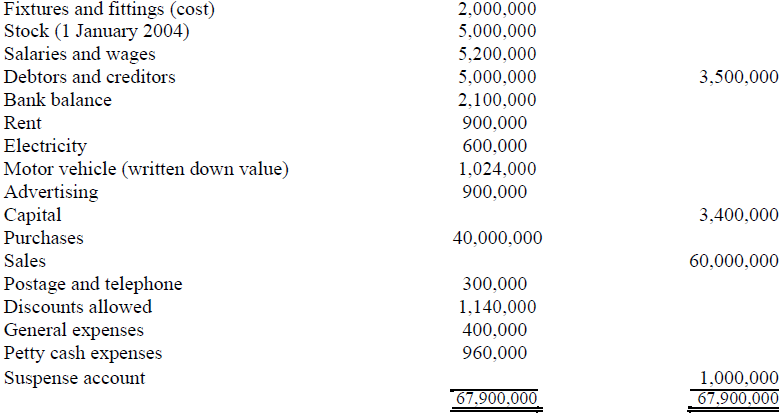
Additional information:
1. Closing stock as at 31 December 2004 was valued at Sh.7,500,000
2. Petty cash balance represents the month end imprest amount. As at 31 December 2004, the petty
cashier had vouchers amounting to Sh40,000 which had not been reimbursed by the main
cashier.
3. Discounts allowed amounting to Sh.100,000 had been posted to the debit of the debtors account.
4. Sales had been undercast by Sh400,000.
5. The motor vehicle, which had been purchased on 1 January 2002, was being depreciated at
20% per annum on the reducing balance basis. The original cost of the motor vehicle was
Sh.2,000,000. It has been decided that the motor vehicle be depreciated at 6% per annum on the
straight line basis and to make the change effective from the date of purchase.
6. Cash withdrawn from the bank for business use amounting to Sh400,000 had not been entered
in the bank column of the cash book.
7. No entry bas been made for stock valued at Sh1,000,000 taken by the proprietor for personal
use.
8. Telephone bills amounting to Sh.100,000 were unpaid as at 31 December 2004.
9. Advertising expenses include the cost of a sales campaign conducted during the year of
Sh.600,000. It is expected that the benefits of this campaign will be enjoyed or the next three
years.
10. Fixtures and fittings are to be depreciated at 20%. per annum on cost.
Required:
a) Trading, profit and loss account or the year ended 31 December 2004.
b) Balance sheet as at 31 December 2004.
Date posted:
May 16, 2019
.
Answers (1)
-
The following trial balance was extracted from the books of Mohammed Kagame, a sole trader, as at
31 October 2004:
1. Stock in trade a s at...
(Solved)
The following trial balance was extracted from the books of Mohammed Kagame, a sole trader, as at
31 October 2004:
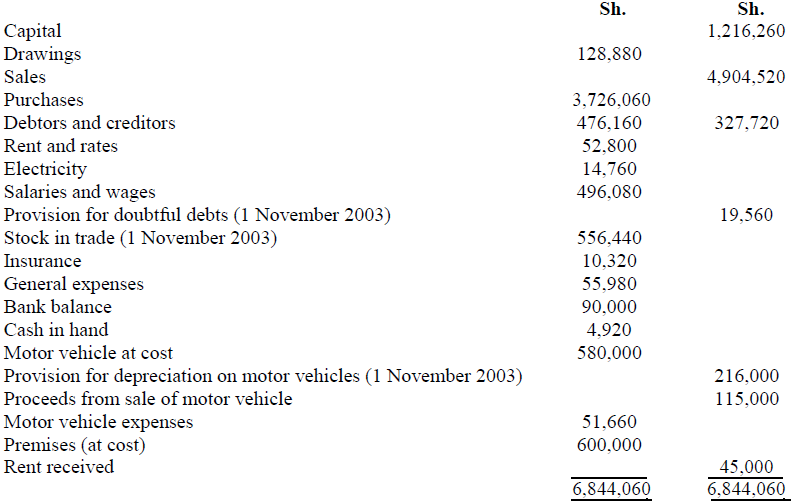
1. Stock in trade a s at 31 October 2004 was valued at Sh593,040.
2. Rates and insurance were prepaid to the extent ofSh.2,400 and Sh.2,820 respectively, as at 3 J
October 2004,
3. Electricity due as at 31 October 2004 amounted to Sh.6,000.
4. The provision for doubtful debts is to be adjusted to S% of the debtors remaining after taking into
account that Sh.20, 1 60 of the debtors were to be regarded as bad.
5. Rent receivable as at 31 October 2004 was Sh. 15,000
6. Depreciation has been and is to be charged on motor vehicles at the rate of 20% per annum on the
straight line basis. No depreciation is to be charged on premises.
7. In November 2003, a motor vehicle which had been purchased or Sh.160,000 on I November
2000, was sold for Sh.115,000. The only record of this disposal is the entry in the proceeds from
sale of motor vehicle account.
Required:
a) Trading and profit and loss account or the year ended 31 October 2004
b) Balance sheet as at 3 I October 2004.
Date posted:
May 16, 2019
.
Answers (1)
-
The following balances were extracted from the books of Patel and Sons in respect of the year ended
31 December 2005:
1. Old furniture which stood in...
(Solved)
The following balances were extracted from the books of Patel and Sons in respect of the year ended
31 December 2005:
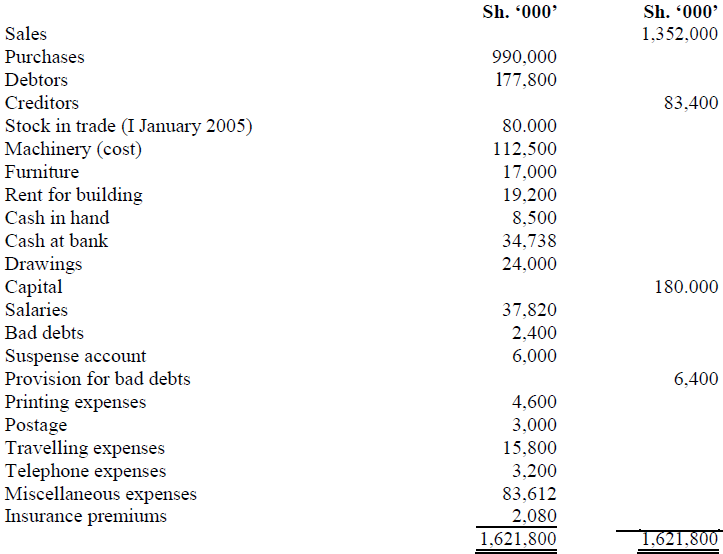
1. Old furniture which stood in the books (as at I January 2005) at Sh.2,400,000 was disposed of at
Sh.1,160,000 during the year in part exchange for new furniture costing Sh.2,080,000. A net
invoice of Sh.920,000 in respect of this transaction was erroneously passed through the Purchases
Day Book.
2. The suspense account represented money advanced to a sales team detailed to undertake a sales
campaign in the Rift Valley Province. On returning, the sales team disclosed that Sh.2,400,000
was used for travelling, Sh.1,000,000 for legal fees and Sh.1,800,000 for miscellaneous
expenses. The balance was yet to be refunded by 31 December 2005.
3. The business is conducted 10 a rented building and 50% or the building is used for
accommodation of the business owner's family.
4. Depreciation is to be provided on the straight line basis at 10%) per annum on machinery and 5%
per annum on furniture. Depreciation is to be applied for the whole year regardless of date of
purchase of the asset.
5. Total bad debts for the year amounted to Sh.4,000,000. Provision for doubtful debts is to be
maintained at 5% of the outstanding debtors
6. Closing stock amounted to Sh100,000,000
7. Insurance premiums cover the one year period ended 31 January 2006.
Required:
a) Trading and profit and loss account for the year ended 31 December 2005.
b) Balance sheet as at 31 December 2005
Date posted:
May 16, 2019
.
Answers (1)
-
The following balances were extracted from the books of Biashara Kubwa Enterprise, a wholesale
business, as at 31 October 2011:
...
(Solved)
The following balances were extracted from the books of Biashara Kubwa Enterprise, a wholesale
business, as at 31 October 2011:
Sh.
Drawings 660,000
Trade receivables 990,000
Purchases 2,303,840
Sales returns 79,420
Capital 4,104,100
Trade payables 330,000
Sales 4,691,280
Purchase returns 120,340
Discount received 93,720
Provision for depreciation: Motor vehicle 176,000
Fixtures and fittings 63,800
Allowance for doubtful debts 44,000
15% bank loan 220,000
Salaries and wages 1,034,000
Discount allowed 54,560
Bank balance 568,260
Cash in hand 26,400
Electricity expenses 103,840
Rent and rates 54,560
Freehold premises (cost) 1,569,700
Fixtures and fittings (cost) 334,400
Motor vehicles (cost) 462,000
Stationery 34,320
Postage and telephone expenses 44,000
Insurance premiums 13,200
Bad debts written off 15,840
Motor vehicle expenses 84,920
Inventory (1November 2010) 1,393,480
Interest on bank loan 16,500
Additional information:
1. The following were the values provided on inventory as at 31 October 2011:
Replacement cost Sh. 1,036,400
Net realizable value Sh. 1,366,200
2. Sales include Sh. 300,000 worth of goods sold by Biashara Kubwa Enterprise agents', who are
allowed 15% commission on such sales. The transaction has not been recorded in the books.
3. Depreciation is to be provided as follows:
Fixtures and fittings 10% per annum on reducing balance basis. Motor vehicles
15% per annum on straight line basis
4. Annual insurance premium amounted to Sh. 12,000
5. As at 31 October 2011, there was a balance of Sh. 65,000 received from a customer in cash
6. Salaries and wages were in arrears of Sh. 35,000
7. The electricity bill for the month of October of Sh. 14,500 was received on 5 November 2011
8. Stationery stock amounted to Sh. 8,750
9. An allowance of 5% is to be maintained for doubtful debts
10.Goods worth Sh. 48,840 had been distributed to potential customers as free samples
Required:
(a) Income statement for the year ended 31 October 2011
(b) Statement of financial position as at 31 October 2011
Date posted:
May 16, 2019
.
Answers (1)
-
Lucy Wabetta operates a wholesale shop. The following information has been provided from her
business records:
1. All receipts are banked and all payments are made from...
(Solved)
Lucy Wabetta operates a wholesale shop. The following information has been provided from her
business records:
1. All receipts are banked and all payments are made from the bank account. A summary of the bank
account for the year ended 30 September 2014 was as follows:
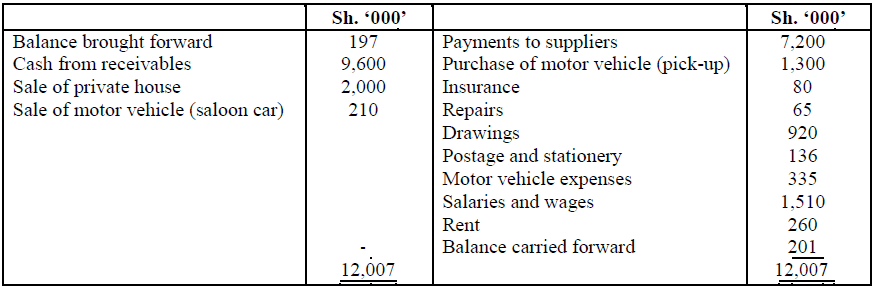
2. Discounts received amounted to Sh.110,000.
3. Assets and liabilities were as follows:
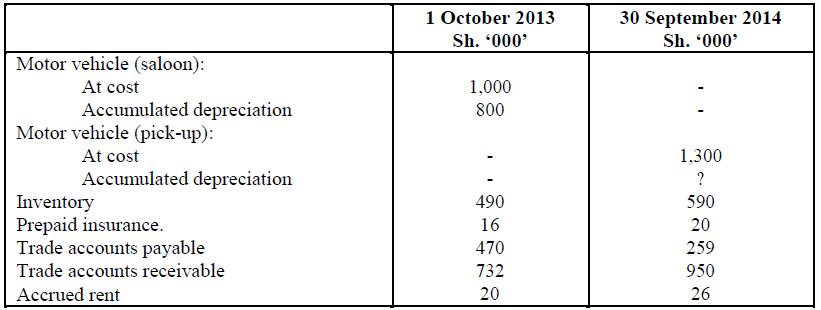
4. Included in the trade accounts receivable as at 30 September 2014 is Sh.30,000 that should be
written off.
5. Provide depreciation at the rate of 20% on cost of the motor vehicles held at the end of each
financial year. No depreciation is provided in the year of disposal.
6. Proceeds from the sale of the private house were capitalized.
Required:
(a) Income statement for the year ended 30 September 2014.
(b) Statement of financial position as at 30 September 2014.
Date posted:
May 16, 2019
.
Answers (1)
-
On 31 December 2001 an inexperienced book-keeper working for Wanji, a sole trader, extracted a
trial balance. Due to errors committed by the book-keeper, the trial...
(Solved)
On 31 December 2001 an inexperienced book-keeper working for Wanji, a sole trader, extracted a
trial balance. Due to errors committed by the book-keeper, the trial balance failed to balance by
Sh.369.400. He placed the difference in a suspense account as shown below:
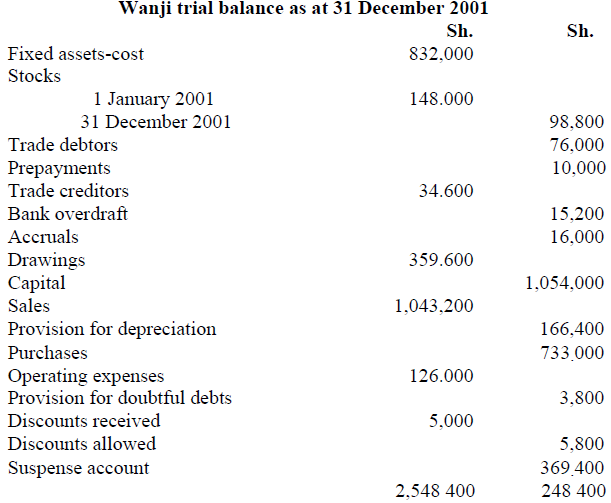
Investigations carried out after preparing the above trial balance detected the following errors:
1. The total of the sales day book for December 2001 was overcast by Sh.25,700.
2. On 2 July 2001 the business purchased office equipment for Sh.40.000. These were debited to
purchases account.
3. Depreciation on the equipment is at the rate of 10% per annum on cost and based on the period
(months) of usage in the year.
4. A payment to a creditor by cheque of Sh.8.500 was erroneously credited to the creditor's account.
5. A payment of Sh.4.500 for telephone expenses was debited to telephone account as Sh.5.400.
6. An amount of Sh.15.000 received from a debtor was not posted to the debtor's account
from the cash book.
7. An amount of discounts received of Sh.2.500 was debited to discounts allowed account.
8. Purchases day book for October 2001 was undercast by Sh.28,000.
9. Assume the business had reported a net profit of Sh.85,800 before adjusting for the above errors.
Required:
(a) The adjusted trial balance and the correct balance of the suspense account
(b) Journal entries to correct the errors (Narrations not required)
(c) Suspense account starting with the balance determined in the adjusted trial balance in (a) above.
(d) The adjusted net profit for the year.
Date posted:
May 16, 2019
.
Answers (1)
-
Ali Osman is a sole trader who operates a retail business. His balance sheet as at 30 April 2004 was as
follows:
Although the trial balance did...
(Solved)
Ali Osman is a sole trader who operates a retail business. His balance sheet as at 30 April 2004 was as
follows:
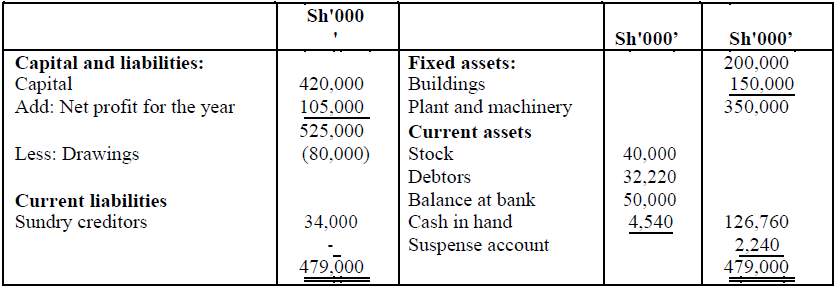
Although the trial balance did not agree, the above balance sheet was prepared and a suspense account
opened to which the difference was posted. At a later date, an inspection of the books revealed the
following:
1. The salaries day book had been overcast by Sh.3,000,000.
1. A payment of Sh. 1,560,000 received from a debtor had been recorded in the cashbook but had
not been posted to the personal account.
2. A discount received 0 Sh.150,000 had been posted to the wrong side of the personal account.
3. The stock book had been undercast by Sh.! 0,000,000 as at 30 April 2004.
4. Bank charges of Sh.850,000 had not been entered into the books.
5. A cash balance of Sh.500,000 had not been included in the trial balance.
6. An invoice for Sh.850,000 for private work commissioned by Ali Osman had been paid by the
business and posted to sundry expenses account.
Required:
a) Suspense account to clear the difference.
b) Statement showing the correct net profit or the year ended 30 April 2004
Date posted:
May 16, 2019
.
Answers (1)
-
a) Briefly explain the following:
i) Error of principle.
ii) Error of commission
b) Joshua Mwalo operates a small hardware shop. He extracts trial balance at the end...
(Solved)
a) Briefly explain the following:
i) Error of principle.
ii) Error of commission
b) Joshua Mwalo operates a small hardware shop. He extracts trial balance at the end of every
month. The trial balance extracted as at 30 April 2005 did not balance, the credits exceeding
the debits by Sh.184, 320. Upon further investigation, the following errors were discovered:
1) A balance of Sh.10,440 on a debtor's account had been omitted from the schedule of debtors,
the total which was entered as debtors in the trial balance.
2) The receipts side o f the cash book had been undercast by Sh.72,900.
3) A credit note for Sh.2l A80 received from a supplier had been posted to the wrong side of
his account.
4) A computer purchased or Sh.144,000 had been written off to general expenses.
5) A debtor whose past debts had been the subject of a provision, paid Sh.87,720 to clear his
account. His personal account had been credited but the cheque had not yet been recorded in
the cash book
6) An electricity bill amounting to Sh.8,240 which had not yet been accrued, was discovered in
a filing tray.
7) The totals in the sales day book had been carried forward as Sh.948,780 whereas the correct
amount was Sh.978,480.
Required:
i) Journal entries to correct the above errors.
ii) Suspense account to dear the difference between the totals of the debit and credit sides.
Date posted:
May 16, 2019
.
Answers (1)
-
a) Explain any four purposes of journal entries in the accounting process
b) Walter Muita, a sole trader, presented the following balance sheet of his business...
(Solved)
a) Explain any four purposes of journal entries in the accounting process
b) Walter Muita, a sole trader, presented the following balance sheet of his business as at 30 June
2005. He asked you to investigate the causes of errors giving rise to the amount in the
suspense account:

You subsequently discovered the following errors:
1. The purchases day book was undercast by Sh.4,000.
2. A telephone head costing Sh.3,000 was bought and the amount was debited to the repairs account.
3. The telephone head is to be depreciated at the rate of 15% per annum as pari of fixtures
and fittings.
4. An amount of Sh.2,000 was omitted from total debtors.
5. Returns outwards of Sh.500 were erroneously entered in the sales book.
6. A payment of Sh.1,250 to a creditor was correctly entered in the cash book but credited to his
account.
7. Goods valued at Sh.l 0,000 were taken by Walter Muita for his own use and no entry has
been made to this effect.
8. A bad debt of Sh 1,250 had been written off
9. A discount received of Sh4,500 had been correctly recorded in the cash book but had been posted
to the wrong side of the discount received account.
Required:
i) Show the necessary journal entries to correct the errors listed above.
ii) Prepare a statement of adjusted profit (or loss) for the year ended 30 June 2005.
iii) Prepare the corrected balance sheet as at 30 June 2005.
Date posted:
May 16, 2019
.
Answers (1)
-
(a) Briefly explain the following types of errors:
i. Error of commission
ii. Error of principle
iii. Complete reversal of entries
iv. Compensating errors
(b) The trial balance of Amanda...
(Solved)
(a) Briefly explain the following types of errors:
i. Error of commission
ii. Error of principle
iii. Complete reversal of entries
iv. Compensating errors
(b) The trial balance of Amanda Ltd as at 30 April 2004 did not balance. On investigation, the
following errors were discovered:
1. A loan of Sh.2,000,000 from one of the directors has been correctly entered in the cashbook
but posted to the wrong side of the loan account.
2. The purchase of a motor vehicle on credit fro Sh.2,860,000 had been recorded by debiting the
supplier’s account and crediting the motor expenses account.
3. A cheque for Sh.80,000 from Ogola, a customer to whom goods are regularly supplied on
credit, was correctly entered in the cashbook but was posted to the credit of bad debts
recovered account in the mistaken belief that it was a receipt from Agola, a customer whose
debt had been written off three years earlier.
4. In reconciling the company’s cash book with the bank statement, it was found that bank
charges of Sh.38,000 had not been entered in the company’s records.
5. The totals of the cash discount columns in the cashbook for the month of April 2004 had not
been posted to the respective discount accounts.
The figures were:
Sh.
Discounts allowed 184,000
Discounts received 397,000
6. The company had purchased some plant on 1 March 2003 for Sh.1,600,000. The payment was
correctly entered in the cashbook but was debited to the plant repairs account. Depreciation on
such plant is provided for at the rate of 20% per annum on cost.
Required:
(i) Journal entries with narrations to correct the above errors.
(ii) Suspense accounts showing the original difference
Date posted:
May 16, 2019
.
Answers (1)
-
Ben Mogaka prepared the following draft balance sheet for BM Enterprises as at 31 December 2005:
Additional information:
On further investigation, the suspense account was discovered to...
(Solved)
Ben Mogaka prepared the following draft balance sheet for BM Enterprises as at 31 December 2005:
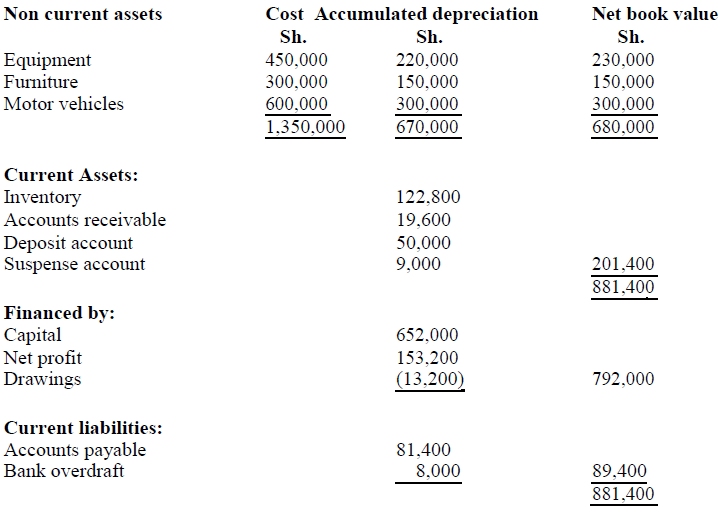
Additional information:
On further investigation, the suspense account was discovered to have resulted from the following
errors:
1. The sales of goods on credit to Alex Otis amounting to Sh.19,000had been recorded in the sales
journal as sh.9,000.
2. A receipt of Sh.20,000 from sale of an item of equipment had been credited to sales account. The
equipment was shown in the books of account at costs of account of Sh.90,000 and accumulated
depreciation of Sh.72,000.
3. A credit note from a supplier, Simon Masound for Sh.15,000 had been omitted from the books.
4. A bank overdraft for Sh.7,000 reflected in the cash book as at 31 December 2005 was omitted In
the trial balance.
5. A payment of Sh. 9,700 to Tom Wambugu, a creditor, was correctly entered in the cahs book but
posted to his personal account as Sh.7,900.
6. The debit side of rent expense account had been undercast by Sh.1,000.
7. A provision of Sh.2,000 for sundry expenses outstanding as at 31 December 2004 and debited to
sundry expenses at that dated had not been brought forward to the credit of the account in the
following period. No credit entry had been made in any other account in respect to this account in
respect to this item.
8. Discount received from the supplier of Sh.8,200 had been entered on the wrong side of purchases
ledger control account.
9. On 31 December, goods valued at Sh.9,600 (selling price) were returned by Jane Kerubo (a
debtor). No entry had been made in the books to reflect this transaction. These goods were not
included in the closing stock.
10. Discounts allowed were overcast by Sh.1,200.
Required:
(a) Journal entries to correct the above errors (Narration not required)
(b) Suspense account.
(c) Statement of corrected net profit for the year ended 31 December 2005
(d) Corrected balance sheet as 31 December 2005.
Date posted:
May 16, 2019
.
Answers (1)
-
After preparation of the trial balance or Bakari Brothers Enterprises as at 31 September 2005, the
firm’s accountant has been provided with the following additional information...
(Solved)
After preparation of the trial balance or Bakari Brothers Enterprises as at 31 September 2005, the
firm’s accountant has been provided with the following additional information for the purpose of
preparation of the final accounts:
1. Due to an oversight, discount has been allowed to a credit customer on the gross invoiced
amount of Sh.80,000 at the rate 10%. The firm should have used a rate if 6%.
2. Electricity accrued amounts to Sh.36,710 while insurance premiums of Sh. 22,450 havebeen
prepaid.
3. In October 2005, the employees of the firm received a general salary increase, backdated to 1
July 2005. Amounts totalling Sh.126,550 in salary arrears are payable to former employees
who left shortly before the salary award was announced and who have not yet been traced. It
has been decided that the salary packets will be opened and the cash banked until the exemployees
are traced.
4. Wages due to casuals amounting to Sh. 464,120 for services rendered in the last week of
December 2005 were paid in January 2006 together with the salaries for the month of
December 2005 which amounted to Sh.301,700.
5. During the year, the exterior of the warehouse was repaired and repainted at a cost of
Sh.500,000. This amount was erroneously debited to office premises account. It is policy of
Bakari Brothers Enterprises to provide for depreciation on the closing balances of non-current
assets and this has already been done. The annual rate of depreciation on office premises is
2% calculated on the straight-line basis.
6. In December 2005 2005, Bakari Brothers Enterprises had bought goods on credit from CB
Ltd. for Sh. 452,100 and has also sold goods on credit to the same company for Sh.163,040.
These amounts were correctly posted to their respective accounts. However, these accounts
are to be offset as at 31 December 2005 and the remaining balance settled by cheque in
January 2006.
7. The provision for discounts allowed to debtors, which at present has a balance of Sh.229,530
needs to be reduced to Sh. 157,400.
8. Debts totaling Sh.64,800 are irrecoverable and should be written off. However, amount of
Sh.21,440 written off as a bad debt in the previous year has now been recovered in full but the
cheque in settlement has not been banked or posted in the accounts.
Required:
Journal entries, including narrations, necessary to record the above transactions in the books of Bakari
Bothers Enterprises.
Date posted:
May 16, 2019
.
Answers (1)